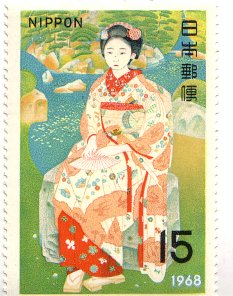
Japan in April
April 5-7: Hikawa-jinja Hanashizume-no-Mai
At the Hikawa-jinja Shrine, Omiya-shi, Saitama. A cherry-blossom dance in which children wear cherry blossoms in their hair and hold branches of blossoms.
April 7,8: The Saturday and Sunday closest; Inuyama Matsuri
Harizuna-jinja Shrine, Inuyama-shi, Aichi. Thirteen parade floats are used in the festival. At night they are decorated with paper lanterns.
April 8: Kombutsu-e: Buddha's Birthday
This is also called the Hana Matsuri or Flower Festival. A small hall called the hanamido is set up at the Buddhist temples and decorated with colorful flowers. Small statues of the child Buddha are decorated with flowers and hydrangea tea is poured over the statue by worshippers.
The tea is prepared in considerable quantity and distributed to festival visitors.
April 7-14: Tsurugaoka Hachiman Shrine Spring Festival
The ancient shrine has an 800-year-old Ginkgo tree by its steps. There are various processions in the costume of the Kamakura Period.
April 12, nearest Sunday to: Shingenko Matsuri
Kofu-shi, Yamanshi. Takeda Shingen was a famous warrior and is honored by this festival. In one highlight of the festival more than 1000 men dressed as warriors stage a mock battle in the city.
April 13: Otaue Shinji
Kumata-jinja Shrine, Osake-shi, Osaka's rice planting festival known for its dance, a puppet play and noh.
April 14,15: Sanno Festival in Takayama
This festival is based on the Gion Festival of Kyoto. It features large floats decorated with rugs and tapestries and featuring various mechanical figures.
April 14-16: Hikiyama Matsuri
Nagahama-hachimangu Shrine, Nagahama-shi, Shiga. Floats are used in this festival and local children aged 5 to 12 will be on them performing kabuki and kyogen.
April 15, 16: Tama-no-Kagura
Chigata-jinja Shrine, Oyama-shi, Tochigi. Children's festival ceremony performed by a group of ten young girls.
April 18: Akadomari Matsuri
Wakamiya Hachiiman-jinja Shrine, Adadomari-mura, Nigata. Children's festival with dances.
April 22: Hidaka Hibuse Matsuri
Hidaka-jinja Shrine, Mizusawa-shi, Iwate
This festival's purpose is to ward off outbreaks of fire. Before WWII almost all Japanese homes were built of paper and wood. Whenever a fire would break out it could spread quickly, a fact demonstrated by the American fire-bombing of Japanese cities which actually did more damage than the atomic bombs.
In this festival musical floats are paraded around the town, some of the floats carrying young girls sitting and playing small drums.
April 25: Magomi Matsuri
Children's festival, Kawaguchi Sengen-jinja Shrine, Kawaguchiko-machi, Yamanashi. This particular ceremony is held in order to keep Mt. Fuji from erupting.
April 29: Greenery Day
This was originally a national holiday that celebrated the birth of the Emperor Showa but now is a day for nature appreciation. Commemorative planting of trees is done across Japan. It was named Greenery Day because the late Emperor Showa had a great love of nature.
April 29: Kyokusui-no-En
This is held at Jonangu Shrine, Kyoto-shi, Kyoto. Kyokusi was a pastime followed by the nobility in ancient times. A lacquer sake cup was set adrift in a stream and the participants, watching on a downstream bank, had to compose a short poem and then drink the sake in the cup when it reached them.
April 29-May3: Uesugi Matsuri
Useugi-jinja Shrine, Yonezawa-shi, Yamagata. Useugi Kenshin was a warrior lord in feudal Japan and this particular festival comemorates him and his followers. This is a parade of people dressed as warriors in costumes of the time along with mock battles being taken place.
First Saturday and Sunday of the month
Tori-jingu Otauesai festival, Katori-jingu Shrine, Sawara-shi, Chiba. Women perform the rice-planting ceremony to music.
Japanese school year starts
The Japanese school year is divided into three terms. The first runs under about July 20 when summer vacation starts. Students come back to school in early September and the second term runs untill about December 25. The final term starts in early January and lasts until late March.
There are various school entrance ceremonies held at this time, again having the principal make opening remarks to be followed by an introduction of the homeroom teachers who then take the students to their room. Unlike American schools, where students change room from one bell to another Japanese students usually stay in the same room all day.
Hanami (Cherry Blossom Viewing

This is a rather variable dated activity since the Japanese islands are so long going North to South that the exact time of blossoming of the cherry trees depends on just how far north one lives. They start appearing in Kyushu around the end of March, get to Tokyo in early April and reach Hokkaido in mid-May.
People go outdoors and hold picnics under the trees to admire the beauty of the blossoms. This is yet another Japanese activity that has ancient roots. Various literary works, dances and paintings have all been inspired by cherry blossoms.
Golden Week
This starts on April 29 and runs about a week, ending during the first week in May. Many workers get a short vacation during this time due to the number of festivals held during that week.
Ombashira Matsuri
Suwa-taisha Shrine, Suwa-shi, Nagano. Large fir trees are cut down and erected on the grounds of the shrine. The ceremony apparently is to represent the rebuilding of the shrine.
Participants include people who help to cut down the tree, people carrying a box containing their "lords" clothes and other possessions, people dressed up as feudal lords and a group of people who sit on the log while another group uses ropes to raise the log to a vertical position.

|